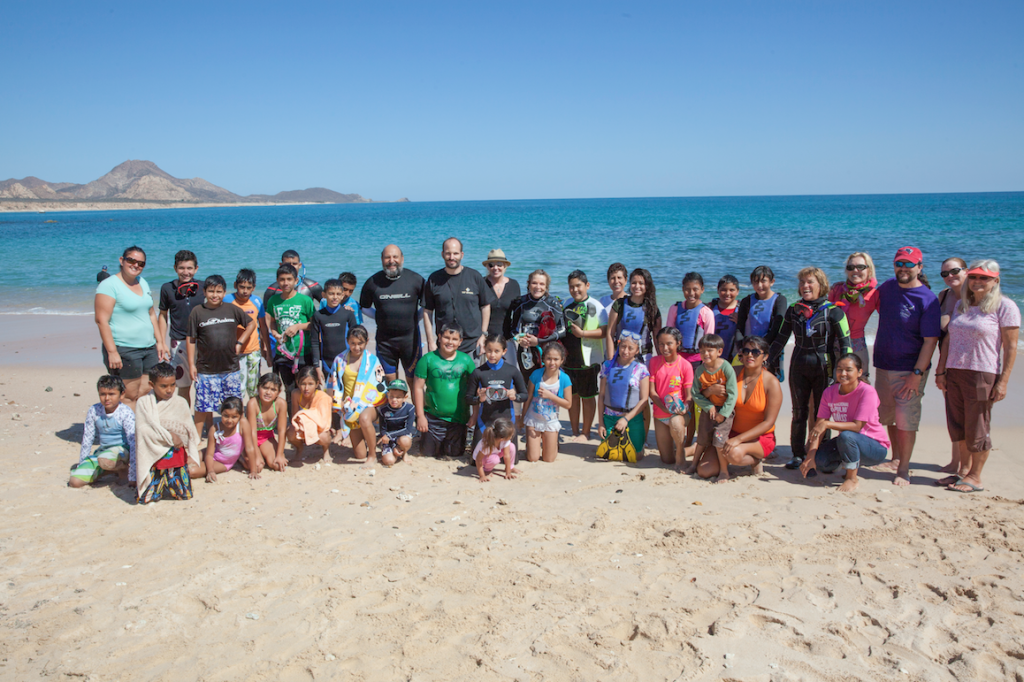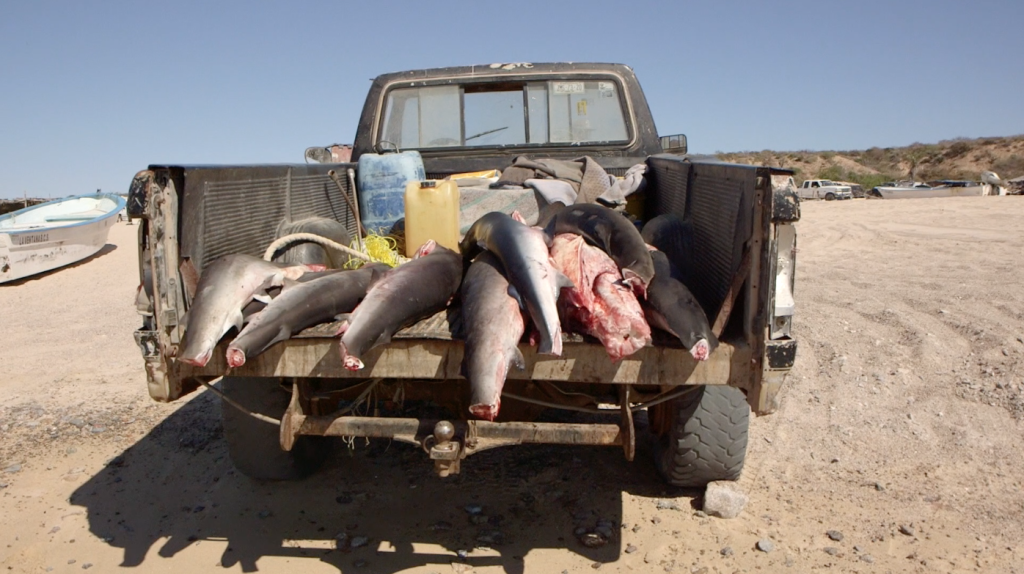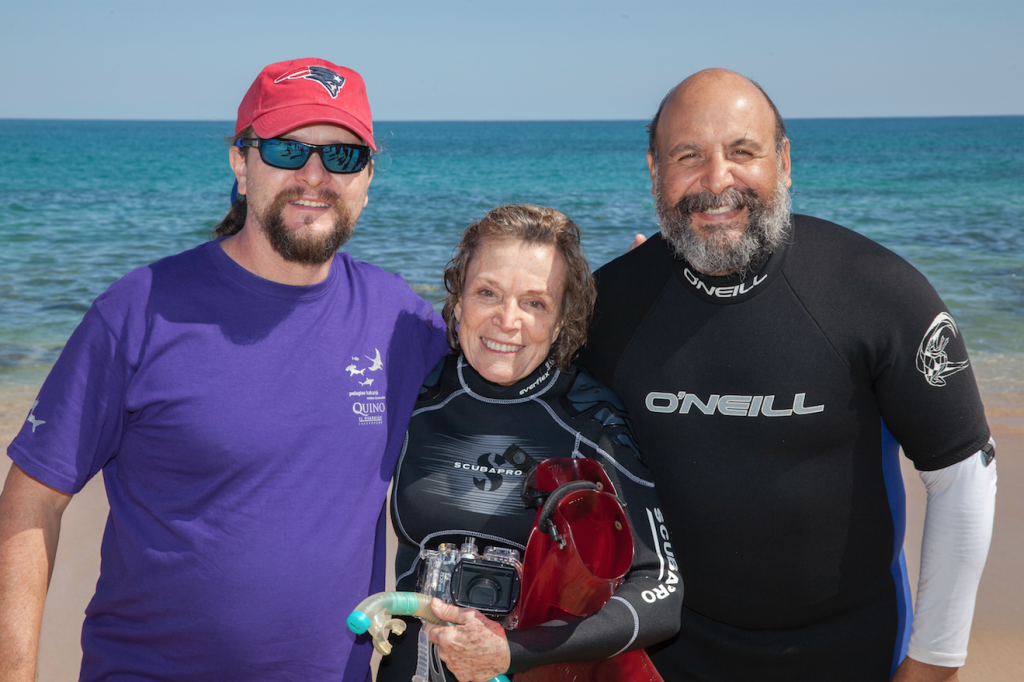Dr. Sylvia Earle Holds up Cabo Pulmo As Model to the World
March 31, 2016
What follows is a transcription of Dr. Sylvia Earle’s speech to the community of Cabo Pulmo on the Mission Blue Hope Spot Expedition to Cabo Pulmo Marine Park in February of 2016
=-=-=
I am deeply honored just to be here and to salute you, all of you. And to the Castro family of Cabo Pulmo, of course, with great respect.
So just in the past year I have had the ability to travel in a number of places in the world to Paris, to the climate conference in December. Before that I was in — in Chile, at an ocean conference with the US secretary of state John Carrey, and the president of Chile co-convened to talk about the ocean. And in New York, in Washington, next week I will be in Australia everywhere people are celebrating and saluting and talking about the miracle that you have accomplished here. It’s true.
And part of the reason that it is resonating with people around the world is that there is a need for hope, a need for seeing a place that has been has declined for one reason or another and then bounced back. When people pull together not only with individual leaders but a community working together, change is possible.

When I was here a couple of years ago, making the film Mission Blue, we went diving with that great whirl pool of jacks and saw the great golden grouper and the other fish that have repopulated the area that is under protection. Then we went down the coast just a few miles and it was totally different. Inside there was like paradise and outside well, you just wonder where are all the fish?
Diving now in Cabo Pomo is almost like diving into the ocean as it was 50 years ago.
It’s not the way it was, but it is a lot better than it otherwise would be. Protection really works. And it’s an idea that is beginning to catch on around the world. One little island country has established an MPA around the whole island, out 200 miles. They have stopped killing sharks, they’ve stopped killing tuna, they’ve stopped killing grouper, they have stopped the killing. Within 20 miles where people still maintain livelihoods and gather food for their families, managed fishing occurs. But it is surrounded by a blue halo of protection that is enormous. And it is working.
Easter Island its a part of Chile, they have done a similar thing just this past year. A big circle of protection out 200 miles. An inner circle that is managed for the benefit of the local people.
In my country, in the United States, the idea of protecting nature really began a 100 years ago with National Parks on the land. Were celebrating this year the centennial of caring for the land, and caring for nature, including the ocean.
When president George W. Bush was in office, he did something important by establishing a large place where even the fish are safe in the US controlled Pacific. President Obama has similarly expanded that area in the Western Pacific and now is considering formal Blue Parks for the United States. This time last year in all of the ocean around the world, 1 % of the ocean was protected. That meant 99% is open for fishing. 1% safe for the fish. The good news is that because of actions just in the past year, inspired by successes like Cabo Pulmo, right now 2% is protected. So 98% is open to fishing. 2% safe. The good news, we have doubled from a year ago. Maybe by this time next year it can be doubled again. Maybe we can be at 4% and if we doubled again, it could be at 8% and just keep it on a roll. If we wait long enough maybe all of the ocean will be safe for the wildlife and creatures living there.
It doesn’t mean that the idea of taking wildlife for food is a bad thing. People have done this for as long as humans have existed. We have taken from nature to support our livelihoods, to support our prosperity.
When my great grandparents were born in 1800, there was one billion people on earth. By the time I came along, into the 20th century, there were 2 billion. Now we have 7 billion people. Our numbers are increasing, but there is a cost: we are consuming the natural world that fosters our prosperity.

And we keep doing this, keep consuming, consuming, consuming. Since I began exploring the ocean, diving in the 1950s, half of the coral reefs have disappeared. 90% of many of the fish, the tunas, the sharks, the swordfish, grouper, snapper, the things we like to take for market – gone. Their numbers have collapsed and the reason is not just because there is 7 billion people. It’s because we have technology that exists today that did not exist 50 years ago. We can find fish. We can catch them. We can send them to the other side of the world. We’re not just feeding families and communities. We’re feeding restaurants, luxury tastes, and exotic menus on the other side of the world.
It’s a lot of bad news you say. The planet is warming. Sea level is rising. What we put into the ocean is poisoning the ocean. The ocean is becoming more acidic.
But there is good news and it really is the best news of all – why I say if you could be born anytime in history, choose right now. For the first time we have knowledge that enables us to see these issues. We could not and did not know when I began exploring the ocean that we can change the ocean. We thought the ocean was too big to fail. We thought we could put anything into the ocean we wanted and we could take anything from the ocean and it did not matter. But now we know that the ocean and life in the ocean holds the planet steady. It makes earth hospitable. It’s our life support system. Not just for sharks or tunas or coral reefs but it’s also vital for us. We need the ocean.

Knowing is the key. If you don’t know you can not care. If you don’t know you got a problem, you can’t fix the problem. I love the fact that this community has leaders that are showing the way, that have taken personal commitments and the community that as a group made a commitment of caring. That island country I mentioned has a leader, a president who was a fisherman. But he experienced in his lifetime what I am describing. He saw the sharks go from abundant to scarce. The tuna from abundant to scarce. The reefs declining. But he also knew that there is still a chance because not all the reefs are gone. There’s still some sharks. He was able to do things such as calculate the value of a live shark to the industry that is more important economically to his little island country than fishing. That industry is tourism.
People, such as I, pay big bucks for the privilege of going to this beautiful island country to swim with the sharks, to visit those beautiful reefs. So a single shark, the economist figured out, was worth about 2 million dollars alive. Two million dollars as long as it was swimming in the ocean attracting people such as I, who want to come look at the sharks swimming alive in the ocean. There are people like that – I am one of them. There are lots of us around the world. Millions of divers and others, even if they don’t get in the water with the sharks, want to know that they are there. It’s like saying, I’m so glad that there are birds in the forest. I may not see them but I know that they are there and I’m glad they are there because they make the forest healthy and beautiful. A dead shark is worth a few hundred dollars, maybe 500 dollars, for the fins. And not to eat, but to serve as a luxury dish in Asian markets. I mean it’s a fact: just in a few decades we see this sharp decline to these creatures that have been swimming in the ocean, maintaining the health of the ocean, for hundreds of millions of years. They are suddenly crashing because a primate species, human beings, have found ways to capture and kill them, and market them on a scale that is unprecedented in all of their history. What a concept, huh?
So here in Mexico, on the other side of Mexico, there is a thriving business where people, and I am one of them, go to see whale sharks. The fisherman who in the past who made a living killing sharks, is now making a better living taking people, such as me, out just to look at the largest fish in the sea, the whale sharks. They don’t kill the sharks, but admire the sharks. Whale sharks can live for 30 or 40 or 50 years, and bring revenue in alive. Or you can kill them once and then its over. You have one good source of income and then its gone. Here in Mexico at the lagoons whale watching has become a thriving business. It used to be where whales are killed and used once. And then it was over. Around the world people have stopped killing whales. A few countries still take whales as commodities but mostly whales are now respected for other reasons. Yes, they can be a source of tourism income, but their value to the ecosystem of the ocean is also now understood in ways we could not know 50 years ago or 100 or 1,000. Now we know – and the same is true with sharks, the same is true with grouper, the same is true with tuna. They are wild creatures and the value of them alive is enduring.
I love how this community celebrates the living value of the creatures that occupy the ocean in your neighborhood. It’s a matter of respecting them as neighbors. You are all part of one system. And their existence right now is very reliant on what you do or what you fail to do. If you let down your guard, if you stop the protection, it would not take long to eliminate the progress you made in restoring what’s here. But, I was out diving today and there was that huge school of jacks and the golden grouper swimming around. They are there as your treasury. It is your bank. It’s your home. A home as much for you as it is for them.

At Mission Blue, we are now accepting nominations for Hope Spots. We have about 200 places that have already been nominated and the list is growing. One thing leads to another and when you can see success, like what you have here in Cabo Pulmo, it inspires people to say, “I want to do in my place what happened in Cabo Pulmo. They’ve succeeded. Maybe we can too.”









We’d like to do series of short articles with pictures regarding
Mission Blue. We respect your work, thank you.
Craig Brood, PhD.
I had the wonderful opportunity to snorkel at Cabo Pulmo in Oct. 2015. Not only was I impressed with the beauty of this protected water, but equally impressed with the people who live there and their willingness not to sell out to the developers who would love to come in and build resorts. The residents of Cabo Pulmo could make a lot of money to sell their land (not to mention develop a paved road to their town), but have chosen their environment and lifestyle over greed. If only others would follow their example!!
Absolutely awsome work you guys are doing that has inspired many in the diving community.